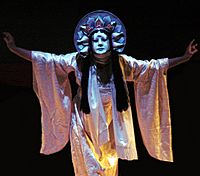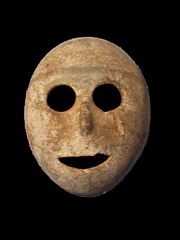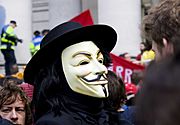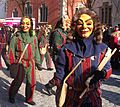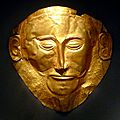Mask facts for kids
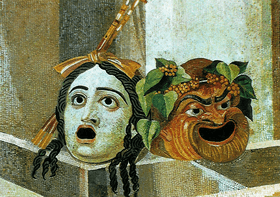
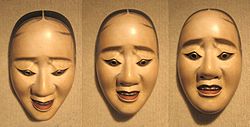
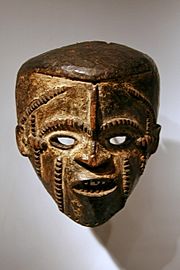
A mask is a type of clothing that covers the face. It is similar to a veil, but it fits more closely to the face. People use masks for many different reasons.
Contents
Why do people use masks?
People use masks for various reasons. Sometimes, a mask helps hide who a person is. For example, someone might wear a mask to keep their identity a secret. Other times, a mask can protect someone's face from harm. A gas mask, for instance, keeps harmful gases from getting into the lungs.
Everyday uses of masks
Many masks are used in daily life for practical reasons. Often, these are semi-masks. They only cover the lower part of the face, like the mouth and nose.
- In hospitals: Doctors and nurses wear masks during surgery. This helps keep bacteria from reaching the patient.
- For safety: Woodworkers wear masks to stop tiny wood fibres from getting into their lungs.
Some masks cover only the top half of the face. Venetian masks are an example. They were used to prevent people from being recognized during parties. Ice hockey masks cover the whole face. They protect players from fast-moving pucks.
Where did masks come from?
The word "mask"
The word 'mask' likely comes from other languages. Words like the French masque and the Italian maschera are similar. The Latin word mascus or masca meant "ghost." The Arabic word maskharah meant "jester" or "person in disguise."
History of masks
One of the oldest masks ever found is called the Death Mask. This stone mask is about 9,000 years old. It is thought to be the oldest mask in the world. You can see it in the Musée de la bible et Terre Sainte in Paris. Three other masks from the same time are kept in The Israel Museum, Jerusalem.
Masks have been used for a very long time in many cultures. In non-western societies, masks are often part of magical or shamanistic rituals. People used them to celebrate or calm spirits. During these events, performers would dance and sing. They wore costumes and masks to pretend to be these spirits.
This early use of masks might have led to their use in ancient Greek theatre. In early Greek plays, all the actors and the chorus wore masks.
Different meanings of "mask"
The word 'mask' can also be used in other ways. These are like metaphors.
- In movies: A mask can be a screen that blocks part of an image.
- In social life: A mask can mean the way a person acts in a certain role or job. For example, police officers or teachers often act in ways people expect. This "role" can be seen as a mask. It suggests that their true self might be different from how they act in their job.
- As a verb: To 'mask' something means to cover or hide it.
Related topics
Images for kids
-
Papierkrattler masks at the Narrensprung 2005 Carnival parade, Ravensburg, Germany
-
The so-called 'Mask of Agamemnon', a 16th-century BC mask discovered by Heinrich Schliemann in 1876 at Mycenae, Greece. National Archaeological Museum, Athens.
-
Theatrical masks of Tragedy and Comedy. Mosaic, Roman mosaic, 2nd century AD
-
Batak mask dance at a funeral feast in the Dutch East Indies, 1930s
-
Masks of Cameroon
-
Fang mask used for the ngil ceremony, an inquisitorial search for sorcerers. Wood, Gabon, 19th century.
-
Aztec mask of Xiuhtecuhtli, c. 1500, of Mixtec-Aztec provenance
-
A Peking opera mask
-
Sanxingdui Bronze Mask with Protruding Eyes, Shu
-
Mask of Tengu
-
Protective reusable filter mask worn by NYPD officer
-
A rib knit three-hole balaclava allows the wearer to protect the face against cold air or hinder recognition.
-
Members of Anonymous wear Guy Fawkes masks while protesting against the Church of Scientology. 2008, London.
-
Man with facepaint which simulates a half-sided mask on Halloween
-
Kwakwaka'wakw, Baleen Whale Mask, 19th century, Brooklyn Museum
-
A Cherokee ceremonial mask made of wood
-
Dance Mask (Takü), 20th century, Brooklyn Museum; These full-body masks are worn for the mourning, or ónyo ("weeping"), ceremony, a multi-day ritual held approximately a year after an individual's death
-
Taiwanese President Tsai Ing-wen wearing a surgical mask during the COVID-19 pandemic
-
Life mask of Ludwig van Beethoven, c. 1812. The Wellcome Collection, London
-
Life mask of Abraham Lincoln by Leonard Volk in 1860.
See also
 In Spanish: Máscara para niños
In Spanish: Máscara para niños


